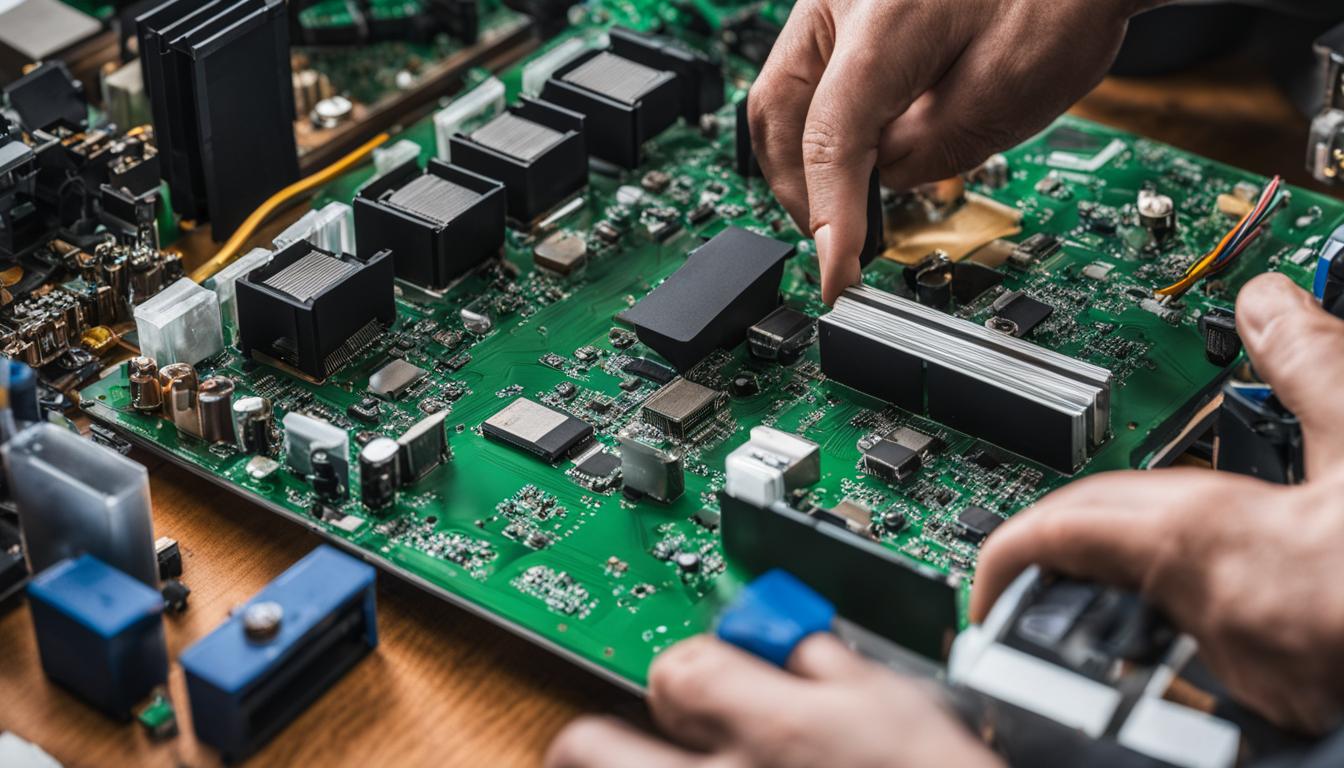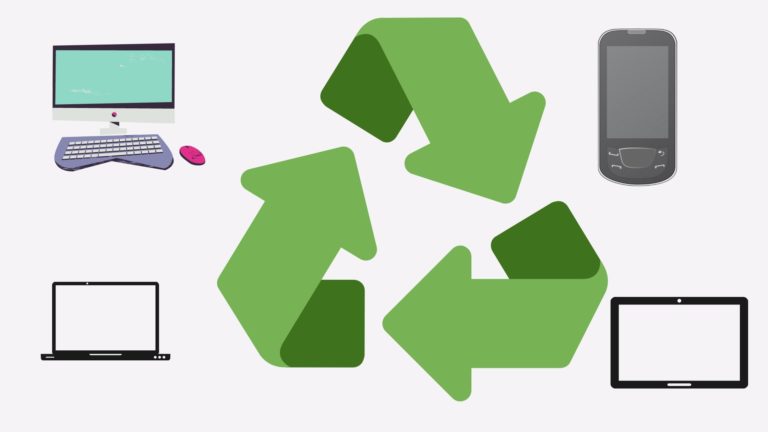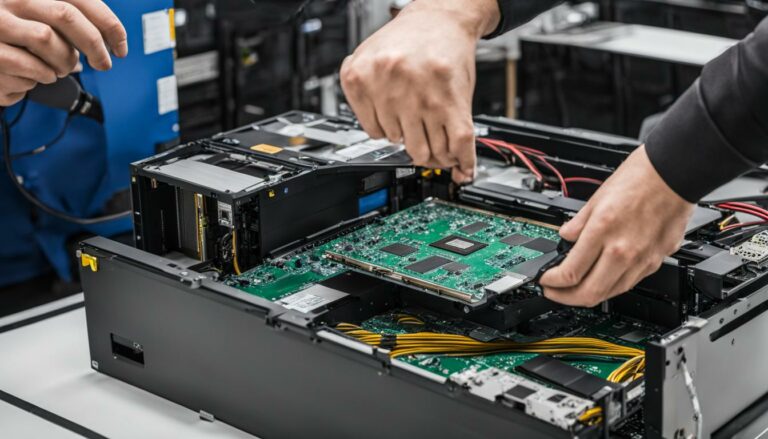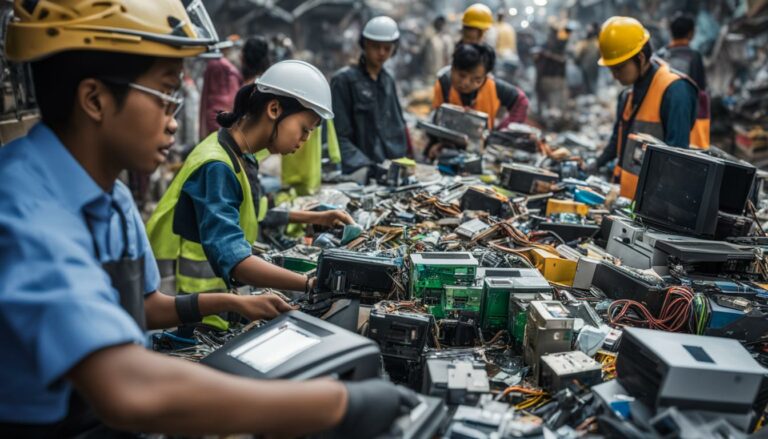The Science Behind Computer Recycling
Computer recycling is the process of dismantling and separating components and raw materials from waste electronics. It involves separating high-value metals from low-value materials such as plastics. Precious metals and rare earth metals play a crucial role in consumer electronic recycling technology. These metals have high market values and limited supplies, making recycling them economically viable. In 2017, approximately 2.8 million tons of consumer electronics were disposed of in the U.S., with about 36% of it being recycled. Recycling electronics is complex and faces challenges such as narrow profit margins.
Key Takeaways
- Computer recycling involves separating valuable metals from low-value materials.
- Precious and rare earth metals have high market values and limited supplies, making their recycling economically viable.
- About 36% of consumer electronics in the U.S. were recycled in 2017.
- Recycling electronics is a complex process with narrow profit margins.
- Properly recycling electronics helps preserve valuable resources and reduce environmental impact.
The Technology of Consumer Electronics Recycling
Consumer electronics play a significant role in our daily lives, from smartphones to laptops and televisions. However, when these devices reach the end of their life cycle, they can become a significant source of electronic waste. To address this issue, the technology of consumer electronics recycling has emerged as a vital solution. By harnessing innovative methods, recycling companies can extract valuable materials from these devices, promoting green computing and responsible electronics recycling.
One of the key technologies used in consumer electronics recycling is the separation of precious metals from other materials. These devices contain valuable resources like gold, platinum, and rare earth metals. For example, cell phones hold more precious metal by weight than raw ore does. To extract these valuable materials, advanced techniques such as shredding or robotic disassembly are employed. These methods allow for the efficient separation of high-value materials from toxic ones, ensuring that they can be reused or sold for their market value.
As the field of consumer electronics recycling continues to evolve, new technologies are being developed to enhance the efficiency of material recovery. Ultrasound and biometallurgy, for instance, are emerging as promising approaches. Ultrasound technology can aid in the separation of different materials by utilizing sound waves, while biometallurgy focuses on using microorganisms to extract metals from electronic waste. These innovations have the potential to revolutionize the recycling industry, enabling more sustainable practices and reducing the environmental impact of e-waste.
With the growing need for responsible electronics recycling and the increasing volume of electronic waste, it is crucial to leverage technology to maximize material recovery and minimize environmental harm. By continually investing in research and development, the industry can find innovative ways to address the challenges of e-waste recycling and promote a more sustainable future.
Table: Comparison of Different Consumer Electronics Recycling Technologies
| Technology | Method | Advantages |
|---|---|---|
| Mechanical Shredding | Breaking down electronic waste into smaller pieces using powerful shredders | – Suitable for large-scale recycling operations – Efficiently separates materials based on size and density |
| Robotic Disassembly | Using robots to dismantle electronic devices and separate components | – Precise and targeted separation of valuable materials – Reduces the risk of human error and injury |
| Ultrasound Technology | Applying ultrasound waves to separate materials based on their density and composition | – Non-destructive and environmentally friendly method – Can recover materials that other methods may miss |
| Biometallurgy | Using microorganisms to extract metals from electronic waste | – Potential for high metal recovery rates – Less energy-intensive compared to traditional methods |
As technology continues to advance, the field of consumer electronics recycling is poised for further growth and innovation. By leveraging these technological advancements, we can ensure that valuable resources are recovered from electronic waste, reducing the need for raw material extraction and promoting responsible and sustainable practices in the electronics industry.
Environmental Impact of Computer Disposal
Improper disposal of electronic waste has a significant environmental impact. Many electronic devices contain toxic substances such as dioxins, polychlorinated biphenyls (PCBs), cadmium, chromium, and mercury. When these devices are disposed of in landfills or incinerated, these harmful substances can contaminate the soil, groundwater, and atmosphere, posing serious risks to human health and ecosystems.
Recycling electronics plays a crucial role in mitigating the environmental impact of computer disposal. By recycling electronic waste, hazardous materials are kept out of landfills and incinerators, preventing their release into the environment. This not only protects our soil, water, and air but also reduces the potential risks for communities living near these disposal sites. Additionally, recycling reduces the need for raw ore mining, which often involves destructive practices that harm natural habitats and contribute to climate change.
“Proper electronic waste management through recycling is essential for sustainable technology and a greener future. It helps to conserve resources, minimize environmental pollution, and protect public health.” – Environmental Expert
Furthermore, recycling electronic waste contributes to the development of sustainable technology. By recovering valuable materials from old devices, such as rare-earth metals and precious metals, we reduce the demand for virgin resources. This, in turn, helps to conserve natural resources, reduce energy consumption, and lower greenhouse gas emissions associated with mining and manufacturing new electronics.
Environmental Impact of Computer Disposal – At a Glance
| Issue | Impact |
|---|---|
| Contamination of soil, water, and air | Potential health risks for humans and ecosystems |
| Landfill space consumption | Reduced availability of land for other purposes |
| Raw ore mining | Habitat destruction and increased greenhouse gas emissions |
| Conservation of resources | Reduction in the demand for virgin materials |
| Energy consumption | Lower energy requirements compared to manufacturing new electronics |
It is crucial that we recognize the environmental impact of computer disposal and take action to ensure responsible electronic waste management. By embracing recycling practices and supporting legislation and initiatives that promote sustainable technology, we can create a greener and more sustainable future for generations to come.
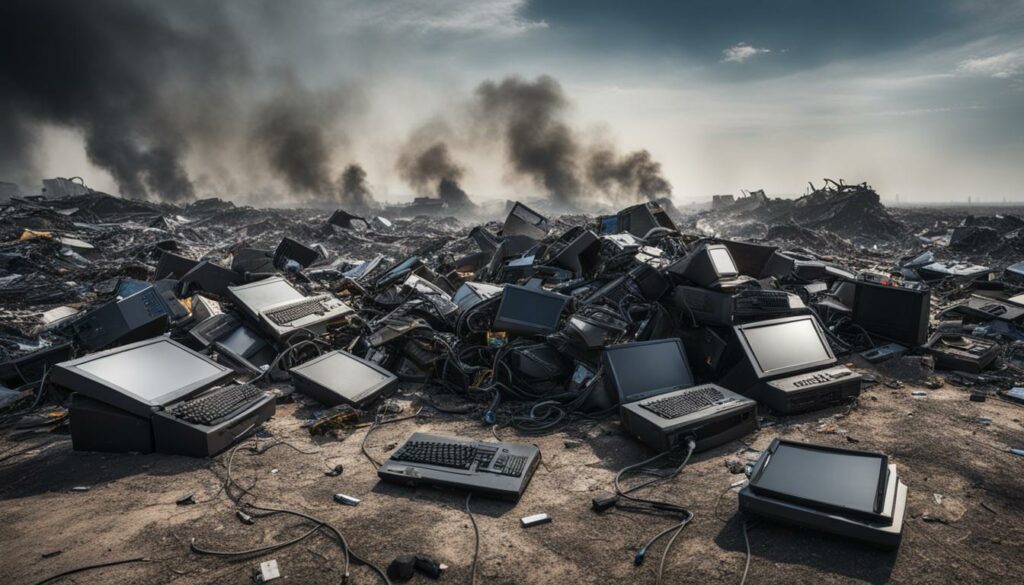
Benefits of Computer Recycling
Computer recycling offers several benefits, both environmentally and economically. By recycling electronic waste, valuable rare-earth metals and precious metals can be recovered, reducing the reliance on overseas sources and promoting domestic business and employment. Recycling also reduces hazardous practices like open-pit burning, which are harmful to the environment and human health. Additionally, developing advanced recycling technologies can lessen the environmental impacts of raw ore mining and landfill disposal of hazardous materials. The proper recycling of electronic waste is essential for creating a circular economy and preserving valuable resources.
One of the significant benefits of computer recycling is IT asset recovery. When businesses recycle their old computers and other electronic devices, they have the opportunity to recover valuable components and materials. These recovered assets can be refurbished or sold, generating additional revenue for the organization. IT asset recovery not only helps companies offset the costs of recycling but also promotes the concept of green computing by extending the lifespan of electronic devices and reducing waste.
Electronic waste management is another key area where computer recycling provides immense benefits. Properly managing electronic waste ensures that toxic substances, such as lead, mercury, and cadmium, are not released into the environment. These substances can have severe impacts on ecosystems, wildlife, and human health. By recycling computers and other electronic devices, these hazardous materials can be safely contained and prevented from causing harm. Electronic waste management is crucial for promoting sustainability and reducing the environmental footprint of the technology industry.
| Benefits of Computer Recycling | IT Asset Recovery | Electronic Waste Management |
|---|---|---|
| Reduces reliance on overseas sources | Generates additional revenue | Prevents release of toxic substances into the environment |
| Promotes domestic business and employment | Extends lifespan of electronic devices | Safely contains hazardous materials |
| Reduces hazardous practices like open-pit burning | Reduces waste and promotes green computing | Promotes sustainability and reduces environmental footprint |
Overall, computer recycling offers numerous benefits, such as IT asset recovery, green computing, and electronic waste management. It not only helps conserve valuable resources and protect the environment but also contributes to the development of a more sustainable and circular economy. By recycling computers and other electronic devices, we can make a positive impact on our planet and ensure a better future for generations to come.
Challenges in Electronics Recycling
The field of computer recycling science and electronic waste management encounters several challenges that need to be addressed for effective and sustainable operations. These challenges range from market limitations to data security concerns and the prevalence of counterfeit parts in the recycling process.
Data Security and Personal Information Protection
One of the significant challenges in electronics recycling is ensuring the secure destruction of personal information stored in devices. Many electronic devices contain personally identifiable information (PII), and improper handling of this data can lead to privacy breaches. While shredding devices may destroy PII, it can also make it harder to recover high-value materials from recycled electronics.
Counterfeit Electronic Parts
Another pressing challenge in electronics recycling is the presence of counterfeit electronic parts. Exported used electronics can serve as a source of counterfeit components, which can disrupt supply chains and compromise the reliability of critical systems like weapons or aerospace equipment. The identification and prevention of counterfeit parts is a constant concern for electronic waste management.
Market Limitations and Costs
The economics of electronics recycling pose challenges due to limited markets for recovered materials and the potential mismatch between the value of these materials and the costs associated with collection, sorting, disassembly, and separation. Narrow profit margins make it essential to find innovative solutions to maximize the recovery of valuable materials while keeping the recycling process financially viable.
In summary, the challenges in computer recycling science and electronic waste management encompass data security, counterfeit parts, and market limitations. Addressing these challenges will require the development of advanced technologies, robust data protection measures, and the establishment of sustainable market mechanisms for recovered materials. With a comprehensive approach, the recycling industry can continue to drive responsible IT asset recovery and contribute to a greener and more sustainable future.
Global Perspectives on Electronics Recycling
The management of electronic waste varies across different countries, with developed nations like Switzerland, Japan, and the European Union leading the way in implementing legislation and regulations to promote responsible recycling practices. These countries have established collection systems and recycling infrastructure to effectively manage electronic waste. On the other hand, developing countries often face challenges in e-waste management, resulting in informal recycling practices that contribute to environmental pollution and occupational health risks.
Improving e-waste management in developing countries is crucial to mitigate the environmental impacts associated with improper disposal and protect public health. It requires the development of appropriate regulations, collection systems, and recycling facilities. Additionally, raising awareness about the importance of responsible electronic waste management and implementing educational initiatives can help to drive positive change.
In the United States, federal and state laws regulate the disposal and recycling of electronic waste. The Resource Conservation and Recovery Act, along with state legislations, addresses the recycling and reuse of computers and other electronic devices. Japan has specific laws for different types of appliances and mandates that sellers and manufacturers recycle certain electronics. However, there are still many countries that lack proper regulations and management systems for e-waste recycling, leading to environmental pollution and health risks.
Electronic Waste Management Practices in Selected Countries
| Country | Collection Systems | Recycling Infrastructure | Regulations |
|---|---|---|---|
| Switzerland | Advanced collection systems with designated drop-off points and collection events | State-of-the-art recycling facilities capable of recovering valuable materials | Strict regulations governing the disposal and recycling of electronic waste |
| Japan | Mandatory recycling programs for various types of electronics | Specialized recycling facilities for different categories of electronic waste | Specific laws and regulations governing the recycling of electronics |
| United States | Collection programs at recycling centers, retail stores, and community events | Well-established recycling infrastructure with facilities that recover valuable materials | Federal and state laws regulating the disposal and recycling of electronic waste |
| India | Informal collection and recycling practices with limited formal infrastructure | Basic recycling facilities, often lacking advanced technology for material recovery | Currently developing regulations to address e-waste management |
Recycling Electronics in Different Countries
Different countries have varying approaches to recycling electronics, with some having comprehensive regulations and management systems in place, while others are still in the early stages of implementing effective e-waste recycling practices. Let’s take a closer look at the recycling landscape in a few countries around the world.
United States
In the United States, electronic waste disposal and recycling are regulated by federal and state laws. The Resource Conservation and Recovery Act and state legislations address the proper recycling and reuse of computers and other electronic devices. These laws aim to promote responsible electronics recycling and prevent the release of hazardous materials into the environment.
Japan
Japan has implemented specific laws for different types of appliances, and sellers and manufacturers of certain electronics are required to recycle them. The country has established collection systems and recycling infrastructure to manage electronic waste effectively. By enforcing these regulations, Japan promotes a circular economy and minimizes the environmental impact of computer disposal.
Global Perspectives
While developed countries like Switzerland, Japan, and the European Union have made significant progress in electronic waste management, developing countries still face challenges in this area. Many developing countries have informal e-waste recycling practices that often lead to environmental pollution and health risks. It is crucial to improve e-waste management in these countries to safeguard public health and mitigate the environmental impacts of computer disposal.
| Country | Regulations | Collection Systems | Recycling Infrastructure |
|---|---|---|---|
| United States | Federal and state laws | Yes | Yes |
| Japan | Specific laws for different appliances | Yes | Yes |
| Developing Countries | Limited regulations | Varies | Varies |
It is evident that there is still work to be done to ensure effective electronic waste management worldwide. By promoting responsible electronics recycling and implementing comprehensive regulations, countries can minimize the environmental impact of computer disposal and move towards a more sustainable future.
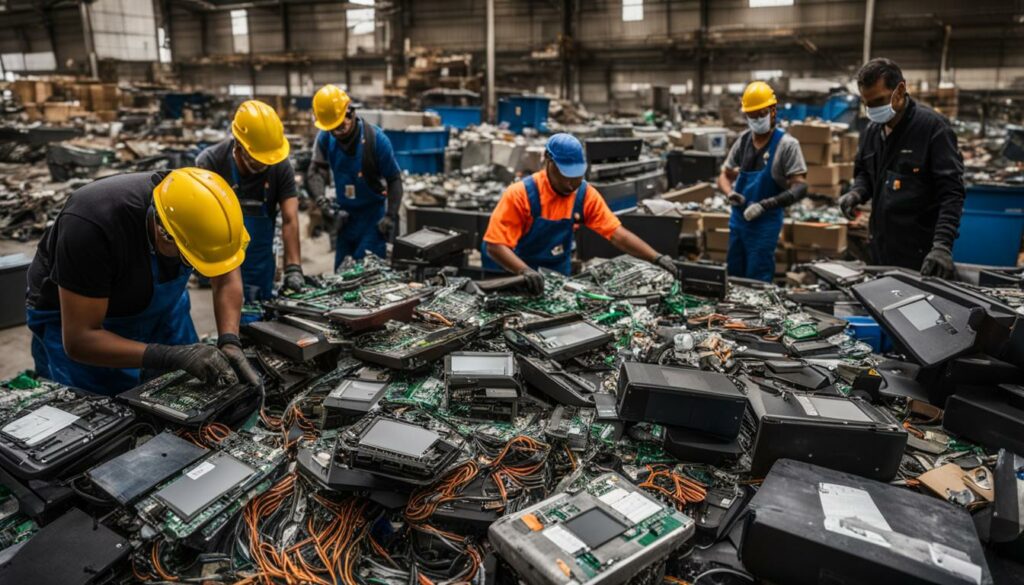
Conclusion
Computer recycling is a critical part of responsible electronics recycling and environmental stewardship. By properly managing electronic waste, we can protect our planet and preserve valuable resources. Recycling not only allows us to recover valuable materials, such as rare-earth metals and precious metals, but also prevents the release of toxic substances into the environment.
Electronic waste management plays a significant role in reducing the need for raw material extraction, which helps us in promoting a circular economy. However, there are challenges that need to be addressed. Market limitations, secure data destruction, and the presence of counterfeit parts pose obstacles to efficient recycling practices.
To maximize the benefits of computer recycling and minimize its environmental impact, it is crucial to develop advanced recycling technologies and implement effective e-waste management systems globally. This will enable us to overcome the challenges we face and ensure a sustainable future.
FAQ
What is computer recycling?
Computer recycling is the process of dismantling and separating components and raw materials from waste electronics to recover valuable materials and prevent environmental pollution.
What materials can be recovered from recycled computers?
Recycled computers contain valuable materials like gold, platinum, and rare earth metals that can be recovered and reused in the manufacturing of new electronic devices.
Why is computer recycling important?
Computer recycling is important because it reduces the need for raw material extraction, prevents the release of toxic substances into the environment, and promotes the development of a circular economy.
What challenges does electronics recycling face?
Electronics recycling faces challenges such as limited markets for recovered materials, secure data destruction, and the presence of counterfeit electronic parts that can disrupt supply chains and compromise the reliability of weapons systems.
How do different countries approach electronics recycling?
Developed countries like Switzerland, Japan, and the European Union have implemented legislation and regulations to manage and promote electronic waste recycling. However, many developing countries still lack proper regulations and management systems for e-waste recycling, leading to environmental pollution and health risks.
What are the benefits of computer recycling?
Computer recycling helps recover valuable materials, reduces reliance on overseas sources, promotes domestic business and employment, reduces hazardous practices, and lessens the environmental impacts of raw ore mining and landfill disposal of hazardous materials.
How can improper disposal of electronic waste impact the environment?
Improper disposal of electronic waste can contaminate the soil, groundwater, and atmosphere with toxic substances like dioxins, polychlorinated biphenyls (PCBs), cadmium, chromium, and mercury. Recycling electronics prevents the release of these hazardous materials into the environment.
What role do precious metals and rare earth metals play in consumer electronic recycling?
Precious metals and rare earth metals have high market values and limited supplies, making recycling them economically viable. These metals are used in consumer electronic recycling technology and can be recovered from waste electronics.

